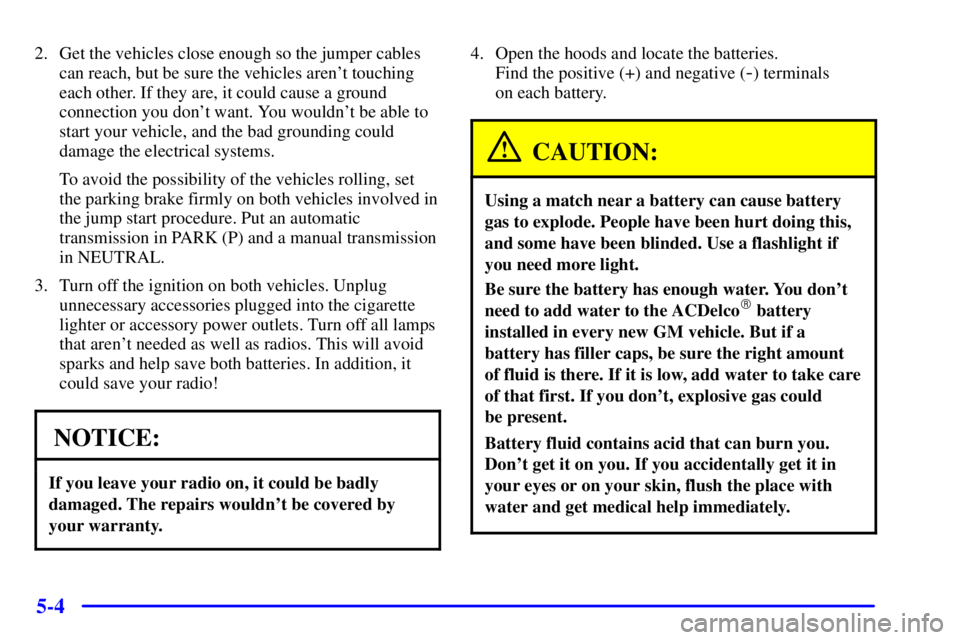Page 222 of 388

5-4
2. Get the vehicles close enough so the jumper cables
can reach, but be sure the vehicles aren't touching
each other. If they are, it could cause a ground
connection you don't want. You wouldn't be able to
start your vehicle, and the bad grounding could
damage the electrical systems.
To avoid the possibility of the vehicles rolling, set
the parking brake firmly on both vehicles involved in
the jump start procedure. Put an automatic
transmission in PARK (P) and a manual transmission
in NEUTRAL.
3. Turn off the ignition on both vehicles. Unplug
unnecessary accessories plugged into the cigarette
lighter or accessory power outlets. Turn off all lamps
that aren't needed as well as radios. This will avoid
sparks and help save both batteries. In addition, it
could save your radio!
NOTICE:
If you leave your radio on, it could be badly
damaged. The repairs wouldn't be covered by
your warranty.
4. Open the hoods and locate the batteries.
Find the positive (+) and negative (
-) terminals
on each battery.
CAUTION:
Using a match near a battery can cause battery
gas to explode. People have been hurt doing this,
and some have been blinded. Use a flashlight if
you need more light.
Be sure the battery has enough water. You don't
need to add water to the ACDelco� battery
installed in every new GM vehicle. But if a
battery has filler caps, be sure the right amount
of fluid is there. If it is low, add water to take care
of that first. If you don't, explosive gas could
be present.
Battery fluid contains acid that can burn you.
Don't get it on you. If you accidentally get it in
your eyes or on your skin, flush the place with
water and get medical help immediately.
Page 318 of 388
6-66
Fuse/Circuit
BreakerUsage
HORN Horn Relay and Horn
A/C COMP A/C Enable Relay and Compressor
RR HTR/AC Rear Heater and A/C
ATC Active Transfer Case
-L Van
FRT HVAC Front Heater and A/C
ENG
-I Oxygen Sensors, Camshaft
Position Sensor, Mass Air Flow
Sensor, Evaporative Emission
Canister Vent Solenoid
IGN
-E A/C Enable Relay Coil
ECM
-I Fuel Injectors 1-6, Crankshaft
Position Sensor, VCM, Coil
Driver Module (EST),
Ignition Coil
Blank Not Used
RH HDLMP Right Headlamp
LH Headlamp Left HeadlampFuse/Circuit
BreakerUsage
Blank Not Used
Blank Not Used
DIODE
-1 A/C
Blank Not Used
Blank Not Used
Blank Not Used
LIGHTING Courtesy Fuse, Pwr. Adj. Mirrors
Fuse, TBC
-Battery Fuse
BATT Power ACCY CB, Stop/Hazard
Fuse, Auxiliary Power Fuse,
Cigarette Lighter Fuse, Radio
Battery Fuse
IGN A Starter Relay, Ignition Switch
IGN B Ignition Switch
ABS Electronic Brake Control Module
Blank Not Used
RAP Radio Accy, Power Windows
HTD MIR/RR
DEFOGRear Window Defogger, HVAC
Control Head
Page 367 of 388

7-46
Automatic Transmission Shift Lock Control
System Check
CAUTION:
When you are doing this check, the vehicle could
move suddenly. If it does, you or others could be
injured. Follow the steps below.
1. Before you start, be sure you have enough room
around the vehicle. It should be parked on a
level surface.
2. Firmly apply the parking brake. See ªParking Brakeº
in the Index if necessary.
NOTE: Be ready to apply the regular brake
immediately if the vehicle begins to move.3. With the engine off, turn the key to the
RUN position, but don't start the engine.
Without applying the regular brake, try to move the
shift lever out of PARK (P) with normal effort. If the
shift lever moves out of PARK (P), your vehicle
needs service.
Ignition Transmission Lock Check
While parked, and with the parking brake set, try to turn
the ignition key to LOCK in each shift lever position.
�The key should turn to LOCK only when the shift
lever is in PARK (P).
�The key should come out only in LOCK.